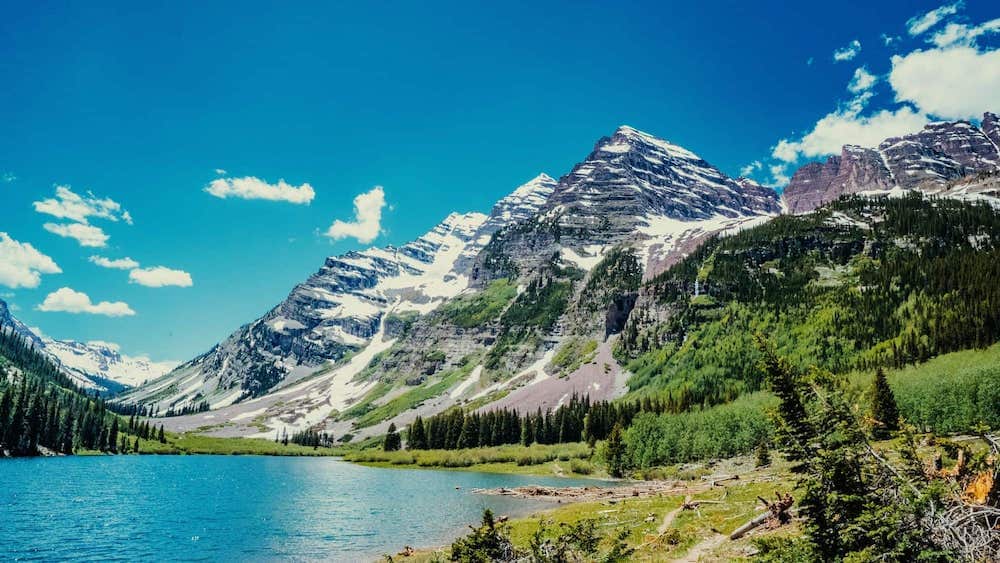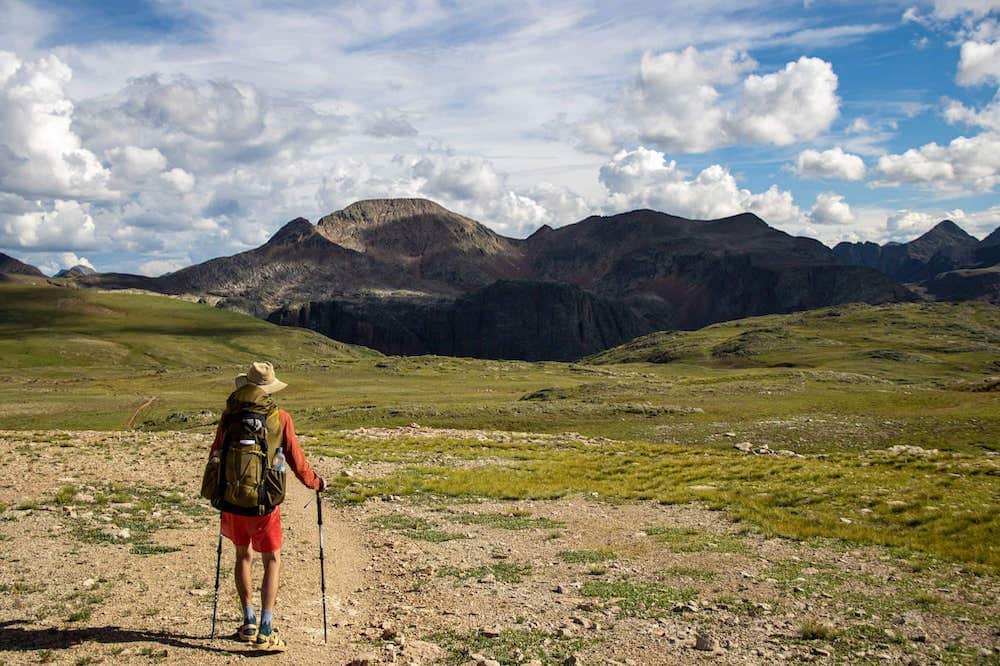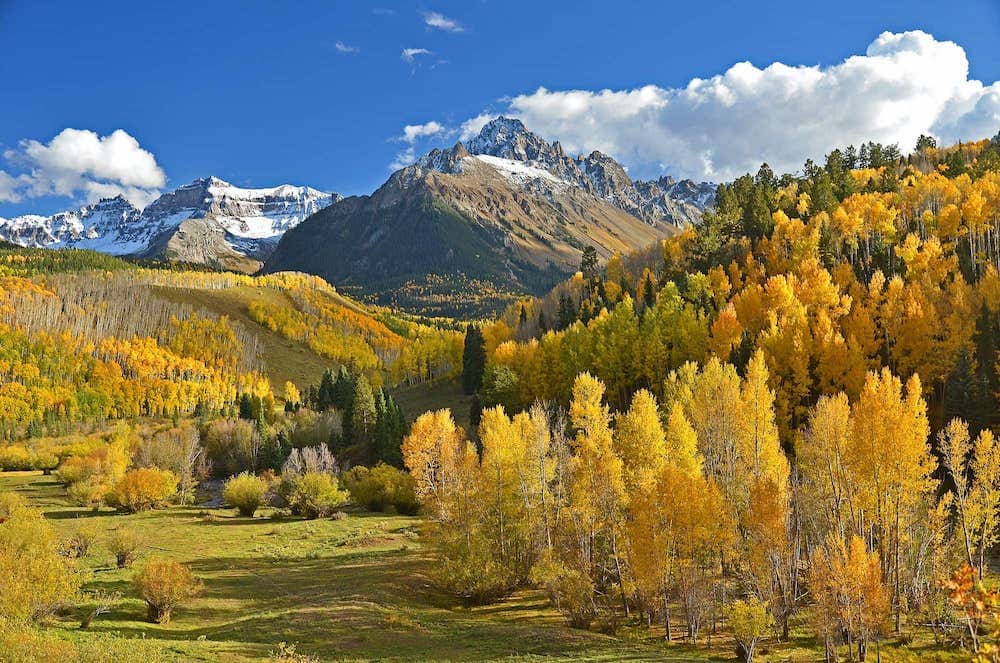
photo by Evan Wise
Are you looking for the best backpacking in Colorado? Not only is Colorado home to some of the most famous backpacking trails in the world, but there are 14 scenic trips in particular that make it truly worth exploring.
In this blog post, we’ll provide you with details about these trails and essential information on how to best prepare for a backpacking trip in one of America’s top destinations for backpacking and wildnerness exploration.
Whether you’re an experienced hiker or just beginning your journey into backpacking, this article will help guide you along Colorado’s fantastic landscape and breathtaking views.
Key Takeaways
- Colorado is home to some of the most famous backpacking trails in the world and has 14 scenic trips worth exploring.
- Popular Colorado backpacking trails include the iconic Colorado Trail, Continental Divide Trail, Chicago Basin in Weminuche Wilderness, Maroon Bells Four Pass Loop, Lost Creek Wilderness Loop and Devil’s Thumb To King Lake Loop.
- Beginner friendly routes include Early Season Backpacking in Lost Creek Wildlife Area; Mohawk Lakes near Breckenridge; and Beginner Route Near Fairplay and are a great way for novices to explore breathtaking wilderness areas with lesser technical difficulties.
- Some of the advanced backpacking trips in Colorado include the Aspen’s Four Passes Loop, the Colorado Trail’s highest thru-hike in America, Lone Eagle Peak, and Wildflowers from Crested Butte to Aspen.
Colorado’s Best Backpacking Trails
From the iconic Colorado Trail and Continental Divide to Devil’s Thumb Loop and Chicago Basin in Weminuche Wilderness, there are numerous backpacking trails offering a wide variety of terrain for experienced backpackers.

photo by Caleb Jack
Colorado Trail
- Length: 500 miles (804.67 km) from Denver to Durango.
- Difficulty Level: Difficult, requiring multi-day hikes across rocky terrain with steep ups and downs.
👉 The Colorado Trail is one of the state’s most iconic backpacking trails and it offers an incredible range of outdoors experiences. Spanning nearly 500 miles from Denver to Durango, it passes through six national forests and wilderness areas including Rocky Mountain National Park.
It is a difficult trail requiring multi-day hikes on rocky terrain with plenty of steep ups and downs, but the rewards are countless stunning views. Along its path are postcard-perfect scenes like Hang Lake, Treasure Fall Trails in San Juan Mountains, Tenmile Range Peaks’ view from Copper Mountain Ski resort to Breckenridge Peak 12 & 13 near Frisco.
Popular destinations include Chicago Basin in Weminuche Wilderness where backpackers can explore scenic mountains by choosing 4 Pass Loop or Blue lakes Trail; Crater Lake in Indian Peaks Wilderness; Lost Creek Wilderness Loop offering gorgeous wildflowers and sweeping vistas over Devil’s Thumb to King Lake loop trail; Maroon Bells Four pass Loop overlooking peaks that soar above 14,000 feet are among many of the must see spots along this amazing route.

photo by Taylor Turtle
Continental Divide Trail
- Length: The Continental Divide Trail (CDT) spans over 3,100 miles (4,989.23 km) along the Rocky Mountains, connecting five U.S. states: Montana, Idaho, Wyoming, Colorado, and New Mexico.
- Difficulty Level: Extremely challenging, typically taking 5 months to hike from start to finish on foot.
👉 The Continental Divide Trail (CDT) is one of the most challenging long-distance hiking trails in the United States, spanning over 3,100 miles along the Rocky Mountains and connecting five U.S. states: Montana, Idaho, Wyoming, Colorado, and New Mexico.
The CDT passes through alpine tundra areas in Colorado such as South San Juan Wilderness area, Weminuche Wilderness area and La Garita Wilderness area offering spectacular views of rugged peaks and meadows carpeted with wildflowers. It typically takes 5 months to hike from start to finish on foot.
Hikers on this iconic trail have several options for experiencing it – from multi-day backpacking trips to scenic road trips; allowing you time for day hikes or shorter section hikes.

photo by John Ward
Chicago Basin in Weminuche Wilderness
- Length: 500 miles (805 kilometers)
- Difficulty Level: Difficult, requiring several days
👉 The Chicago Basin Trail in Weminuche Wilderness is one of the best backpacking destinations in Colorado. Located in the rugged heart of the San Juan Mountains, this area is surrounded by 14,000 ft peaks and offers a variety of incredible trekking opportunities.
The basin can be accessed via Durango & Silverton Narrow Gauge Railroad and has been popular with backpackers for years as it provides remote hiking experiences through miles of trails in its wilderness area.
Not only is the area perfect for multi-day trips, but it’s also home to four beautiful 14ers – mountain peaks with an elevation of at least 14,000 feet (4,267 meters) – at Mt Eolus, Windom Peak, Sunlight Peak and several others – making for some spectacular climbing routes too!
Maroon Bells Four Pass Loop
- Distance: Approximately 28 miles (45 kilometers)
- Difficulty Level: Challenging
👉 The Maroon Bells Four Pass Loop is considered one of the best backpacking trails in Colorado, offering trekskers a challenging and rewarding adventure.
Sitting at 12,000 feet in elevation and spanning 28 miles long over four days and three nights, this loop hike takes adventurers into some of the most breathtaking scenery Colorado has to offer.
Starting from the Maroon Bells scenic area it goes through Trail Rider Pass with stunning views of Snowmass Lake before ending up back where hikers started. Along the way, they’ll traverse majestic alpine meadows while making their way across all five biomes found in Colorado: Shrubland/Forest, Foothills, Alpine Tundra/Rocky Mountain Boreal Forest Valleys/Great Plains Grasslands.
The trail offers unique terrain features like shale slides and swamps as well as amazing seasonal wildflowers for color along its journey.

photo by Thomas Morse
Lost Creek Wilderness Loop
- Distance: Approximately 25 miles (40 kilometers)
- Difficulty Level: Moderate to Challenging
👉 The Lost Creek Wilderness Loop is a stunning backpacking trail located in the heart of Colorado. This 28-mile loop loop is considered difficult with its varying landscapes and views. It winds through Hankins Pass, Lake Park Trail, and McCurdy Park Trail with spectacular tree-lined mountain parks, granite domes and arches; this journey takes an average of 13 hours and 40 minutes to complete.
When you’re traveling along these wilderness paths, make sure to keep your eyes open for wild animals like black bears, bighorn sheep deer or elks on the way! An additional enticement for swimmers are various lakes built over time which have been reserves as campsites along the way – sweet relief after trekking 187 square miles within wilderness area at about 50 miles from both Denver & Colorado Springs!
Devil’s Thumb to King Lake Loop
- Length: 14.75 miles (23.7 kilometers)
- Difficulty Level: Moderate
👉 Devil’s Thumb to King Lake Loop winds through breathtaking forests and alpine meadows in Indian Peaks Wilderness, located north of Boulder, Colorado.
Hikers can enjoy stunning mountain views, cascading streams and wildflowers beginning from the trailhead at Devil’s Thumb Lake – one of the popular destination points on the loop. As you continue along this challenging trail, trekking up steep sections that offer unparalleled sights of Rocky Mountains – with Lone Eagle Peak standing tall among them – hikers will make their way towards connecting routes such as High Lonesome Trail leading to King Lake before returning back along same route to Devil’s Thumb Lake for a memorable journey.
Not only does it present an opportunity to explore the fascinating wilderness region but also offers a chance to appreciate its diverse wildlife and flora while walking amongst mesmerizing beauty that surrounds it all yearlong!
Crater Lake in Indian Peaks Wilderness
- Difficulty Level: Moderate
👉 The Crater Lake route is located in Grand County, and offers spectacular views of Colorado’s majestic mountains and wild landscapes on a challenging 17-mile round trip hike up to an incredible 2,298 feet in elevation gain.
With its wild setting, Crater Lake provides backpackers with unforgettable mountain vistas unparalleled by other hiking destinations. Along the way campers can take in pristine alpine lakes surrounded by lush wilderness areas that create truly breathtaking scenes.
For those seeking even more adventure without traveling far from Crater Lake, other hikes including Monarch Lake to Crater Lake and Lone Eagle Peak provide added challenge while still providing stunning backcountry experiences found within the Indian Peaks Wilderness.

photo by Matthew Hernandez
Zirkel Circle
- Distance: Approximately 11 miles (17.7 kilometers)
- Difficulty Level: Moderate to Challenging
👉 The Zirkel Circle Trail near Steamboat Springs is an 11-mile loop hike takes you through the stunning Zirkel Wilderness, an area of 159,935 acres managed by the U.S. Forest Service and traversing across two different trails – Gilpin Lake and Gold Creek Lake Trails.
It is popular among both beginner backpackers and experienced hikers alike due its challenge yet manageable nature as it allows them to take in all the spectacular landscape en route like wildflowers, rugged peaks, expansive meadows, scenic forests and alpine lakes – absolutely perfect for a memorable Colorado backpacking experience!
Beginner-Friendly Backpacking Routes in Colorado
Entry level backpacking trails offer hikers of all levels the opportunity to discover the beautiful wilderness areas in Colorado, including Early Season Backpacking in the Lost Creek Wilderness, Mohawk Lakes near Breckenridge, and a beginner-friendly route at Fairplay.
Early Season Backpacking in the Lost Creek Wilderness
Lost Creek Wilderness in Colorado is a popular destination for early season backpacking, offering beginner-friendly trails, stunning landscapes and unique experiences. Lost Creek Wilderness is often the first area to open for backpacking in the Colorado high country and the last to close, making it an attractive choice for hikers looking to hit the trail as soon as possible.
Popular destinations within Lost Creek Wilderness include Ute Peak Trailhead, Hessie Trailhead and Goose Creek Trailhead. Wildflower displays dominate during springtime when mountain creeks are rushing down its bountiful valleys, while its expansive aspen forests provide ample space late summer long into autumn.
The 28 mile long Lost Creek Wilderness Loop will take one through impressive granite formations with towering peaks, alpine lakes and above treeline views. Additionally experienced backpackers can opt for either short duration hikes or tougher multiple day challenges such as scaling Lone Eagle Peak or tackling 14ers in Chicago Basin – there’s something here for every type of backpacker!
For those just getting into backpacking, some great introduction trails are the Hessie Trail including trekking up —> to summit near Death Pass before heading over toward Indigo Lake where you can pitch camp under millions of stars, surrounded by breathtaking scenery.
Mohawk Lakes Trail near Breckenridge
👉 Offering stunning mountain views, two beautiful alpine lakes, a waterfall, and some exciting mining ruins for exploration, the Mohawk Lakes backpacking trail near Breckenridge is one of Colorado’s best beginner-friendly hikes.
Located 3.3 miles from downtown Breckenridge, this hike leads through varied terrain including open meadows and dense forests before reaching the awe-inspiring two lakes: Upper Mohawk Lake at a higher elevation than Lower Mohawk lake.
The trailhead for start of the trip can be easily accessed via Village Road in Breckenridge with additional options for lodging nearby. The child-friendly hike requires some scrambling at points but rewards trekkers with picturesque waterfalls and old mining ruins along its route to Wildflower Heaven on Earth!
Buffalo Peaks Loop, Fairplay
- Length: 7 miles (11 kilometers)
Located just south of Fairplay, the Buffalo Peaks Loop is one of Colorado’s most enjoyable and scenic routes for beginner backpackers. This high-alpine loop offers views of two peaks in the Mosquito Range and several alpine lakes and meadows.
It’s a great spot to gain experience without having to commit to a huge distance or difficult elevation changes since the trail can be finished in less than a day with just over 1,500 feet in total elevation change.
With its peaceful atmosphere, diverse landscape, and abundance of wildflowers–Buffalo Peaks Loop is ideal for those starting out as backpackers who want more from their adventure than simply getting all your gear set up!
Along this route, you’ll get sweeping vistas of high mountains covered by evergreens forests while also enjoying an abundance of wildlife such as elk, deer, bighorn sheep, or even moose roaming through the area.
Moderate Backpacking Trails in Colorado
Intermediate level hiking offer a great balance of challenge and potential for adventure, with routes such as the Backpacking to Lone Eagle Peak, Wildflowers from Crested Butte to Aspen, Colorado 14ers in the Chicago Basin, and Willow Lakes in the Gore Range.
Backpacking to Lone Eagle Peak
- Length: 14.8 miles (23.8 kilometers)
Located in Colorado’s Indian Peaks, Lone Eagle Peak is known for its mix of beauty and challenging backpacking trails. This hike to the summit has an elevation gain of over 2,000 feet and involves a strenuous climb with a full pack.
While hiking this trail, you will cross into 17 different permit zones, as per quota limit within the wilderness which offers some of best backcountry hiking opportunities across Colorado state.
The breathtaking sights along the way include waterfalls (like Cascade Falls) and iconic peaks like Lone Eagle Cirque where hikers take can take once in a lifetime photos of landscapes along their journey.
Crested Butte to Aspen
From early spring to late summer, Crested Butte to Aspen provides nature enthusiasts with an array of vibrant and colorful wildflowers. The mountainous valleys between Crested Butte and Aspen are carpeted in a myriad of blues, purples, pinks and yellows.
Commonly seen species include the Colorado Columbine, Indian Paintbrush, Avalanche Lilies, Fireweed and Blazing Stars. One especially unique species is the Colorado state flower – the Aspen Sunflower – which blooms around August in some years providing hikers with fields of golden petals that stretch as far as the eye can see.
All these dazzling flowers bring life to this region of Colorado’s wilderness; creating stunning landscapes throughout every season sure to make any hiker’s journey unforgettable!
Backpacking Colorado 14ers in the Chicago Basin
- Length: 21-38 miles (33.80 – 61.26 kilometers)
The Chicago Basin in Colorado is one of the most popular backpacking destinations offering stunning views, challenging trails and the opportunity to climb three 14ers – Mount Eolus, Sunlight Peak and Windom Peak – in one amazing trip.
This strenuous hike totals has an elevation gain of approximately 8,000 ft (2,438 m). Due to its difficulty level, this trek is often listed among the best backpacking routes in Colorado for experienced hikers looking for a remote wilderness experience.
From wildflowers to breathtaking views and high altitude forests, there’s something magical about hiking these 14ers that captivates outdoor enthusiasts from all around the world. With proper preparation including obtaining permits and mapping out your route ahead of time you’ll be sure set out on a safe adventure worthy of bragging rights!
Backpacking Willow Lakes in the Gore Range
Offering a challenging mix of steep inclines, rugged trails and stunning views, the trek to Willow Lakes is a must-visit destination for backpacking enthusiasts in the Summit County area.
The area is known for its abundant wildflowers, providing hikers with an unforgettable experience when seeking out scenic mountain beauty. As you make your way along the Gore Range Trail between Boulder Lakes and the split to Willow Lakes expect some hot and dusty sections which will test anyone’s stamina before they reach their final destination.
For those who survive these inclines, Upper Willow Lake awaits along with Salmon Lake both of which sit beautifully amongst Eagles Nest Wilderness famed jagged mountains as well as blooming alpine meadows dotting landscape on all sides – perfect for experienced adventurers seeking intense physical exercise tinged with awe inspiring sights!
Challenging Backpacking Trails in Colorado
Advanced backpacking trails in Colorado include Aspen’s Four Passes Loop, the Colorado Trail’s highest thru-hike in America, Lone Eagle Peak, and Wildflowers from Crested Butte to Aspen.
Backpacking Gore Lake, the Best Alpine Lake in Colorado
- Length: 13 miles (20.92 kilometers)
Located in the Gore Range of Vail, Colorado, Gore Lake is considered to be one of the best alpine lakes in the entire state for backpacking. This trail offers an exciting and challenging experience that winds through aspen groves, meadows filled with wildflowers, and stands of pine trees.
Along this path lies a stunning lake whose sandy shore resembles that of a beach giving it its nickname ‘Sandbeach Lake’. Backpacker’s will find breathtaking landscapes along their route while exploring the beauty of nature situated atop 12 415 feet above sea level.
This incredible destination also provides convenient access to beautiful alpine lakes near Vail making it ideal for both beginners and seasoned backpackers alike looking for easy or difficult treks around majestic mountain ranges amidst lush green terrain secluded by crystal clear streams cascading into shimmering blue waters offering angling opportunities accompanied by mesmerizing views fit to steal your breath away time and time again!
Aspen’s Four Passes Loop
- Distance: Approximately 26 miles (41.8 kilometers)
This loop is a renowned 26 mile (42 km) backpacking route located in the Maroon Bells – Snowmass Wilderness of Colorado. It’s an iconic multiday trip that takes approximately 3-4 days to complete, climbing over four 12,000+ ft passes and offering breathtaking views and stunning scenery throughout.
Hikers start at Aspen’s iconic Maroon Bells, known for its magnificent beauty, eventually making their way around the full loop before returning to the same starting point. The Four Pass Loop is immensely popular among backpackers, hikers and campers alike due to its immense natural beauty and international reputation as an authentic outdoor experience.
When finishing this challenging hike there are usually tears of joy from those completing it – displaying how emotionally powerful of a journey this loop truly is! The trail offers diverse terrains including high alpine lakes, wildflower meadows and dense forests with plenty opportunities to spot elk or deer along the way.
The Colorado Trail: The Highest Thru-Hike in America
Hikers from all over the world flock to Colorado to experience its spectacularly rugged terrain and breathtaking natural views – but no backpacking trip would be complete without treading a section of The Colorado Trail.
Stretching 486 miles along some of America’s highest – and most challenging – mountainous trails, this thru-hike is considered by many dedicated hikers as one of their ultimate bucket list experiences.
From Denver to Durango, gapless single track provides an unparalleled journey through diverse terrain during which hikers can take in serene meadows, babbling brooks such as Jefferson Creek at 10,000 feet elevation and rugged Gore Lake in the Gore Range alpine lake.
Whether taken on for part or all of it’s length — prepare for brisk weather that changes frequently so suitable clothing needs to meet warm Summer days and chilly nights alike.
Sky Pond via Glacier Gorge Trail, the Best Backpacking Route in Rocky Mountain National Park
Rocky Mountain National Park is considered by many to be one of the best backpacking destinations in the state of Colorado. The Sky Pond via Glacier Gorge trail is arguably its most popular, combining challenging terrain, jaw-dropping views and unforgettable alpine scenery.
This eight-mile roundtrip route begins with a steep ascent through wooded pine forests before winding up at the awe-inspiring Sky Pond lake. From here, trekkers can take in magnificent views of nearby mountains and other landmarks like Hallet Peak, Black Lake and Taylor Peak as they continue their journey around the loop.
Trekking along such a scenic route definitely demands a moderate level of fitness as it involves climbing large rock steps and traversing numerous switchbacks with some sections that are even quite exposed have been known to cause vertigo in novice hikers – so safety should always remain top priority during your adventure here!
Those looking for an easier experience may prefer exploring part of the Tonahutu Creek Loop Trail, which meanders through open meadows full of wildflowers amidst staggering mountain peaks just beyond reach.
Tips for Backpacking in Colorado
Staying safe and prepared on the trails is essential for a successful backpacking journey in Colorado – read on to discover more!
Prepare for changing weather conditions
Colorado is well-known for its unpredictable weather and rapid changes in climate. Backpackers should be aware of the ever-changing weather patterns of Colorado, especially when they are traveling higher elevations and further away from civilization.
Dressing in layers is key to preparedness as temperatures can vary greatly even over a few hours. It’s also essential to keep an eye out for storm clouds coming up from the west, which are common during summer afternoons.
Before any backpacking trip it’s crucial to double check the weather forecast as conditions can change rapidly at higher elevations or deeper parts of Colorado’s wilderness areas. Expect variations in temperature, precipitation, wind speed and direction throughout your journey – thunderstorms, lightning strikes, snowfall and hail all occur on occasion along trails like The Colorado Trail at higher altitudes so be sure you’re carrying sturdy shelter if there is a chance of inclement weather.
Researching historical data for the area you plan on visiting may help provide insight into expected temperature swings as well; for instance Rocky Mountain National Park often experiences bursts of cold air arriving suddenly from Canada with accompanying wintry mix that can thicken quickly making snowshoeing necessary even in mid-summer months.
Pack lightweight and versatile gear
Packing the right gear and clothing for backpacking in Colorado is essential to ensure a rewarding trip. Lightweight and versatile pieces like convertible hiking pants, customizable jackets, and other multifunctional apparel can help minimize weight while accommodating changing conditions on the trail.
Additionally, having lightweight items that offer dual purpose—like an insulated jacket also serving as a quilt—can save space without compromising comfort or convenience. Backpackers should stick to technical fabrics that are lightweight yet durable enough; backpackers should opt for materials such as nylon or ripstop construction which provide needed durability against abrasion, water resistance, temperatures fluctuations, etc., all of which occurs naturally in Colorado’s diverse backcountry terrain.
By packing lightweight and versatile gear tailored to suit outdoor environments like those found in Colorado’s wilderness areas, backpackers have greater confidence and increased chances of succeeding on lasting adventures through scenic trails within the Centennial State.
Carry sufficient water and food
When venturing into the backcountry of Colorado, it is essential to bring enough water and food to stay hydrated and nourished throughout the trip. Dehydration is a serious risk in high-altitude environments, while inadequate nutrition can lead to exhausted energy levels or even hypothermia during colder months.
Local experts advocate carrying ample amounts of water as well as non perishable items such as grains, nuts, dried/canned fruits, jerky for adequate sustenance when hiking in Colorado.
It’s important to calculate how much each person needs per day and plan accordingly before setting off on your journey. Even short hikes should involve bringing more than one liter of water plus an extra snack just in case!
Follow Leave No Trace principles
The Leave No Trace Center for Outdoor Ethics provides seven principles that offer a framework for minimal impact practices for outdoor enthusiasts such as backpackers. These principles are essential to ensure the preservation of Colorado’s natural places and their beauty.
By preparing ahead, following wildlife regulations, minimizing campfire impacts, respecting other visitors’ experiences, disposing of waste properly and leaving natural artwork undisturbed we can promote responsible outdoor behavior in Colorado.
Following the Leave No Trace Principles is also important to reduce human-related environmental damage by encouraging travelers to be mindful of how they travel through landscapes so as not cause any harm or disruption.
Essential Information for Colorado Backpacking
It’s important to know the season, necessary permits and safety considerations before planning a backpacking trip in Colorado.
Backpacking season in Colorado
can be variable due to the weather, but typically runs from late May/early June through mid-September. The best time for backpacking in Colorado is during the summer months when days are longer and temperatures are warmer.
However, storms and afternoon thunderstorms are a real hazard so backpackers need to plan accordingly and prepare for changing conditions throughout their trip. The elevation of areas also has an impact on the temperature changes; higher altitudes tend to be colder than lower elevations which makes it important to bring extra layers of clothing regardless of the season.
Rainy or snowy weather may occur at any time so hikers must always carry rain gear as well as warm attire such as waterproof jackets, fleece tops, insulated pants, gloves and hats.
Preparing for your trip
It’s essential to prepare thoroughly before embarking on a backpacking trip in Colorado. Here are some important steps to consider:
- Research to select an appropriate route and destination for your skills, experience and interests.
- Ensure you have the right backpack that fits comfortably with everything you need for the duration of your trip.
- Always carry the “Ten Essentials” when hiking in Colorado (map, navigation device, first-aid supplies, knife/tool, flashlight/headlamp, extra clothing layers and waterproofs, firestarter kit, food & snacks plus 1+ liter water capacity).
- Pack lightweight and versatile gear including basic items like tent or tarp shelter; sleeping bag & pad; cooking system; eating utensils like plates/bowls and cup or mug; hygiene items such as toothbrush & biodegradable soap etcetera..
- Make sure all necessary permits are obtained prior to departure if required by area regulations for your selected location( camping permits etc.).
- Seek advice from local experts who can recommend good hikes depending upon the season conditions of specific areas in Colorado at given time period7Practice safe backpacking techniques such as bearing navigational knowledge ;carrying bear spray if needed preparedfor potential hazards & wildlife encounters travelling slowlyin stairs while venturing uphills wearing sturdy bootswith traction keepinggroup size small consideringwhere one should store their food appropriately 8 And always tell someone aboutone’s plansbefore going out on abackpacker trail !
Safety considerations and precautions
While outdoor activities such as backpacking in Colorado come with inherent risks, there are precautions you can take to stay safe.
- Make sure you are well aware of COVID-19 guidelines before heading out on a backpacking trip.
- Maintain physical distance from other hikers, wear necessary personal protective equipment and carry extra supplies to mitigate virus transmission.
- Take safety measures against accidental encounters with wildlife while hiking in Rocky Mountain National Park or the wilderness areas of Colorado.
- Make sure your pack includes essential gear – a map, compass, first-aid kit, fire starter, medications, insulated blanket or jacket, extra food and water.
- Follow the safety tips outlined by The Colorado Trail for a stress-free journey across America’s highest thru hike trail system.
- When camping or hiking near bear country, double-bag all food items and keep them away from your tent or vehicle at night. Avoid approaching bears at any cost, feeding them, or trying to get too close for pictures—remember they’re wild animals!
Required permits and regulations
When backpacking or day-hiking in Colorado, make sure you’re familiar with the requirements for permits and regulations. Depending on which natural area you will be visiting, you may need one or more in order to access the area or camp overnight.
Popular permit areas include wilderness areas like Rocky Mountain National Park and Indian Peaks Wilderness; some trails are subject to special regulation and require the purchase of a backcountry permit before accessing them.
State Wildlife Areas also have their own set of rules that must be followed when visiting – notably requiring permits from the Colorado Parks and Wildlife (CPW). Other locations such as state parks require passes for access, these can range from daily passes up to annual park admission fees depending on your needs.
Conclusion
Backpacking in Colorado is a particularly unforgettable experience that offers stunning landscapes, diverse terrains, and unique opportunities for exploration. With hundreds of beautiful trails across the state from beginner-friendly routes to Alpine passes adventure seekers can find the perfect backpacking route.
Short day hikes or multi-day adventures offer hikers unparalleled access to natural beauty whether through rocky peaks, alpine lakes, or verdant valleys – all with breathtaking views.
Famous trail like the Continental Trail Divide Loop and Maroon Bells/Four Pass Loop are just some of the must^visit experiences for backpackers visiting the Rocky Mountains while novice adventurers have plenty to take on as well at locations like Lost Creek Wilderness loop or Mohawk Lakes Backpacking near Breckenridge.
With an abundance of wildlife sightings and vast open areas within many national parks in Colorado it remains one of America’s premier backpacking destinations worth exploring again and again.
Related Posts:






